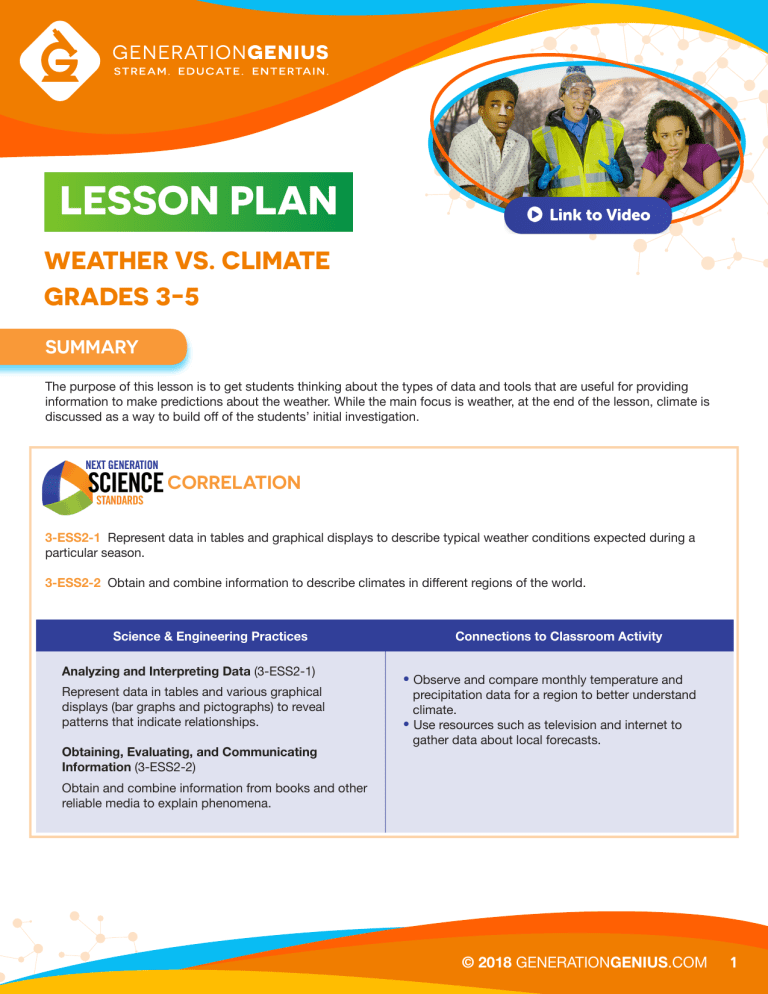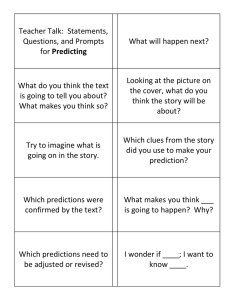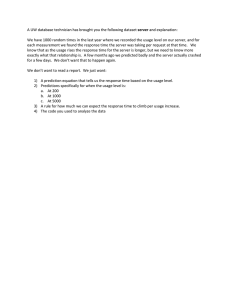
LESSON PLAN Link to Video WEATHER VS. CLIMATE GRADES 3-5 SUMMARY The purpose of this lesson is to get students thinking about the types of data and tools that are useful for providing information to make predictions about the weather. While the main focus is weather, at the end of the lesson, climate is discussed as a way to build off of the students’ initial investigation. CORRELATION 3-ESS2-1 Represent data in tables and graphical displays to describe typical weather conditions expected during a particular season. 3-ESS2-2 Obtain and combine information to describe climates in different regions of the world. Science & Engineering Practices Analyzing and Interpreting Data (3-ESS2-1) Represent data in tables and various graphical displays (bar graphs and pictographs) to reveal patterns that indicate relationships. Obtaining, Evaluating, and Communicating Information (3-ESS2-2) Connections to Classroom Activity • Observe and compare monthly temperature and • precipitation data for a region to better understand climate. Use resources such as television and internet to gather data about local forecasts. Obtain and combine information from books and other reliable media to explain phenomena. © 2018 GENERATIONGENIUS.COM 1 Disciplinary Core Ideas ESS2.D: Weather and Climate Scientists record patterns of the weather across different times and areas so that they can make predictions about what kind of weather might happen next. (3-ESS2-1) Climate describes a range of an area’s typical weather conditions and the extent to which those conditions vary over years. (3-ESS2-2) Connections to Classroom Activity • Investigate how and what types of weather data help inform weather predictions. • Compare weather and climate by attempting to • make predictions for weather the next day and in the future (based on climate data). Think about how climates vary in different locations. Crosscutting Concepts Patterns (3-ESS2-1, 3-ESS2-2) Patterns of change can be used to make predictions. DURATION Two to three 45-minute classroom periods (students complete weather prediction on day one, collect forecast data at home that night, and use it in class the following day) PRE-ASSESSMENT QUESTIONS Please see Discussion Questions located under the video. These can be discussed as a group or answered individually in student science notebooks. ENGAGE Students should complete the Engage and Explore portions of this lesson without looking at weather forecasts. Have students look out the window or take them outside. Ask them to describe the weather today. Ask them what they think the weather will be like tomorrow? How do they know? 2 © 2018 GENERATIONGENIUS.COM Connections to Classroom Activity • Observe, measure, and record patterns in weather data over various time scales to predict weather patterns and climate in their location. MATERIALS • Tools to collect weather data such as temperature, wind speed and direction, air pressure, and precipitation (as available) Science notebooks Pencils Envelope (optional) Access to Internet or television weather forecasts (at home or at school) Monthly temperature and precipitation graphs (local and from other climates) DIY Activity Materials One plastic straw Two paper plates Marker Pencil with a new eraser Scissors Tape Poster board Straight pin Ruler Modeling clay Table fan • • • • • • • • • • • • • • • • EXPLORE Ask students to individually make a quick prediction about what the weather will be like the next day and why they think so. This should be done without any information other than what they observe outside today. These can be made in science notebooks using red pen, or they can be made on pieces of paper, collected and sealed in an envelope to ensure they won’t be changed. Next ask students what kind of data they could collect today that would help them make a more accurate weather prediction for tomorrow. For example, temperature. Facilitate a group discussion to get students thinking about what kinds of data are used to predict weather (they might come up with things like—is it windy or not? Is it rainy or sunny?). Try to encourage them to think about ways these things could be measured. If students come up with ideas, and tools are available (such as a thermometer), work as a group to collect data. Allow the students to create a second prediction based on their increased knowledge (this should be separate from the first prediction, not a revision). Students need to support their predictions. For example, they might have originally said “I think it will be warmer tomorrow,” but now they might say “I think it might be 78 degrees tomorrow since it’s 75 today.” EXPLAIN Instruct students to come to class the following day with a local weather forecast for the next day. They can watch the news or look online. Encourage them to ask their parents for help. At the start of the next class period, allow students to share the forecasts they found. How do these compare to their forecasts? Was their first or second more accurate? Was the professional forecast accurate? Why? WATCH THE GENERATION GENIUS WEATHER VS. CLIMATE VIDEO AS A GROUP Then facilitate a conversation using the Discussion Questions. Also return to the previous discussion about student forecasts based on what they learned about forecasting weather from the video. ELABORATE To follow up on their earlier weather prediction investigation, students can build a wind vane like Zoe’s using the DIY Activity. They can use this and any other tools that are available (barometer, anemometer, rain gauge, or online data) to try to create a more accurate forecast for the following day. Now ask students to make a prediction about what the weather will be like on their birthday (or choose random dates throughout the year). Ask them to explain how they know. Do they know for sure what the weather will be like that day? What evidence are they basing their prediction on? If they are traveling on their birthday, will their prediction still hold true? Facilitate a discussion about the difference between weather (what the weather is like from day to day) and climate (the weather conditions prevailing in an area in general or over a long period). Introduce monthly temperature and precipitation data into the conversation. Show examples for your region and others for comparison. © 2018 GENERATIONGENIUS.COM 3 EVALUATE Use the exit ticket below for students to show you their understanding of weather and climate. Students must write their answers individually and turn in to leave class. You are packing for a long trip to a new place. You are packing a suitcase with clothes to wear now, and shipping a box with clothes you will need later. How do you know what to pack in which box? What information do you need? (To plan what you will need for both now and later you need to know something about both the weather and the climate where you are going. To determine what the weather will be like in the next few days, so you can pack your suitcase, you can look at local forecasts for the area. It’s too early to know exactly what the weather will be like each day months from now, but you can look at patterns of weather over longer periods of time to figure out what to pack. Monthly temperature and precipitation graphs for your destination will provide the information you need to pack your box.) EXTENSIONS • Arrange a visit with a local meteorologist. • Set up a weather station outside the classroom and collect data over longer periods of time. 4 © 2018 GENERATIONGENIUS.COM “Next Generation Science Standards” is a registered trademark of Achieve, Inc. A non-profit dedicated to raising academic standards and graduation requirements. Lesson plan written by Mountain Goat Instructional Design.


